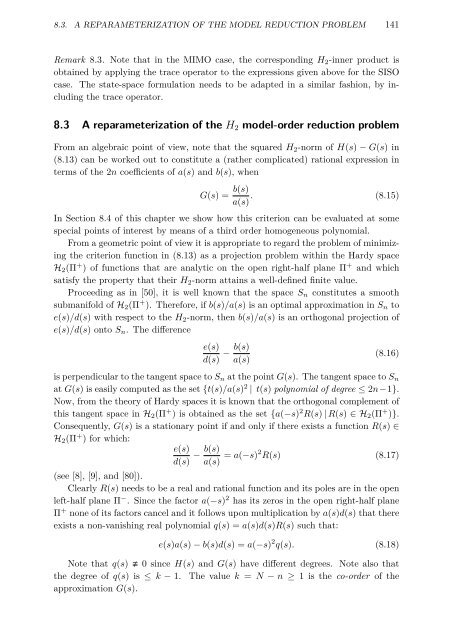link to my thesis
link to my thesis
link to my thesis
You also want an ePaper? Increase the reach of your titles
YUMPU automatically turns print PDFs into web optimized ePapers that Google loves.
8.3. A REPARAMETERIZATION OF THE MODEL REDUCTION PROBLEM 141<br />
Remark 8.3. Note that in the MIMO case, the corresponding H 2 -inner product is<br />
obtained by applying the trace opera<strong>to</strong>r <strong>to</strong> the expressions given above for the SISO<br />
case. The state-space formulation needs <strong>to</strong> be adapted in a similar fashion, by including<br />
the trace opera<strong>to</strong>r.<br />
8.3 A reparameterization of the H 2 model-order reduction problem<br />
From an algebraic point of view, note that the squared H 2 -norm of H(s) − G(s) in<br />
(8.13) can be worked out <strong>to</strong> constitute a (rather complicated) rational expression in<br />
terms of the 2n coefficients of a(s) and b(s), when<br />
G(s) = b(s)<br />
a(s) . (8.15)<br />
In Section 8.4 of this chapter we show how this criterion can be evaluated at some<br />
special points of interest by means of a third order homogeneous polynomial.<br />
From a geometric point of view it is appropriate <strong>to</strong> regard the problem of minimizing<br />
the criterion function in (8.13) as a projection problem within the Hardy space<br />
H 2 (Π + ) of functions that are analytic on the open right-half plane Π + and which<br />
satisfy the property that their H 2 -norm attains a well-defined finite value.<br />
Proceeding as in [50], it is well known that the space S n constitutes a smooth<br />
submanifold of H 2 (Π + ). Therefore, if b(s)/a(s) is an optimal approximation in S n <strong>to</strong><br />
e(s)/d(s) with respect <strong>to</strong> the H 2 -norm, then b(s)/a(s) is an orthogonal projection of<br />
e(s)/d(s) on<strong>to</strong>S n . The difference<br />
e(s)<br />
d(s) − b(s)<br />
a(s)<br />
(8.16)<br />
is perpendicular <strong>to</strong> the tangent space <strong>to</strong> S n at the point G(s). The tangent space <strong>to</strong> S n<br />
at G(s) is easily computed as the set {t(s)/a(s) 2 | t(s) polynomial of degree ≤ 2n−1}.<br />
Now, from the theory of Hardy spaces it is known that the orthogonal complement of<br />
this tangent space in H 2 (Π + ) is obtained as the set {a(−s) 2 R(s) | R(s) ∈H 2 (Π + )}.<br />
Consequently, G(s) is a stationary point if and only if there exists a function R(s) ∈<br />
H 2 (Π + ) for which:<br />
e(s)<br />
d(s) − b(s)<br />
a(s) = a(−s)2 R(s) (8.17)<br />
(see [8], [9], and [80]).<br />
Clearly R(s) needs <strong>to</strong> be a real and rational function and its poles are in the open<br />
left-half plane Π − . Since the fac<strong>to</strong>r a(−s) 2 has its zeros in the open right-half plane<br />
Π + none of its fac<strong>to</strong>rs cancel and it follows upon multiplication by a(s)d(s) that there<br />
exists a non-vanishing real polynomial q(s) =a(s)d(s)R(s) such that:<br />
e(s)a(s) − b(s)d(s) =a(−s) 2 q(s). (8.18)<br />
Note that q(s) 0 since H(s) and G(s) have different degrees. Note also that<br />
the degree of q(s) is≤ k − 1. The value k = N − n ≥ 1 is the co-order of the<br />
approximation G(s).

















